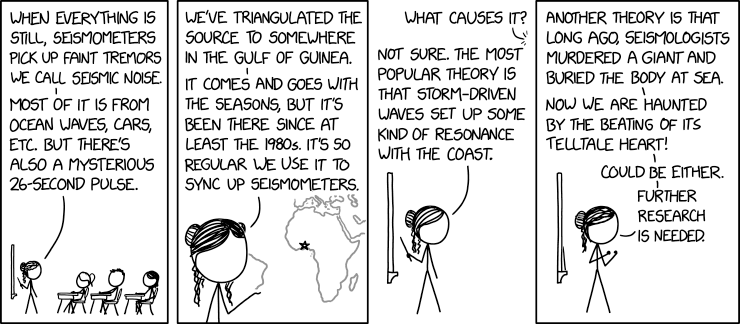26-Second Pulse

There are some papers arguing that there's a volcanic component, but I personally think they're just feeling guilty and trying to cover the trail.

There are some papers arguing that there's a volcanic component, but I personally think they're just feeling guilty and trying to cover the trail.
In this comic strip, Jill is presenting her project on geology to her classmates and is explaining some of the non-earthquake signals that seismometers detect. She describes a mysterious signal that repeats with a 26-second period. Scientists have exploited this signal to correct for clock drift in historic seismic records.
Jill initially provides a plausible explanation (some kind of natural wave pattern on the coastline of the Gulf of Guinea, which is in fact the most common theory about this signal). However, she quickly takes a turn for the dramatic when she claims that it might be a giant, murdered by seismologists, whose heart still beats. This is a reference to Edgar Allan Poe's short story The Tell-Tale Heart, in which the main character murders a man and hides his corpse beneath the floorboards, and then hears (or believes he hears) his victim's heart continuing to beat; the noise eventually drives him to confess his guilt to visiting police officers. (The narrator of The Tell-Tale Heart never uses that phrase in the story; he calls it a hideous heart.) "The Tell-Tale Heart" was previously referenced in 740: The Tell-Tale Beat.
Normal human hearts beat much more rapidly than once every 26 seconds, but large animals and hibernating animals may have much slower heart rates (which would include a giant at the bottom of the ocean).[citation needed]
The title text gives an alternate explanation for the seismic activity: volcanic activity, but Jill continues to believe in the giant story. In the last panel she references the common science meme that further research is needed, which has been mentioned several times in previous strips, including 2268: Further Research is Needed.
A seismometer is a device for measuring vibrations in the earth's crust, and one is likely in the collection of Cueball from 2060: Hygrometer.